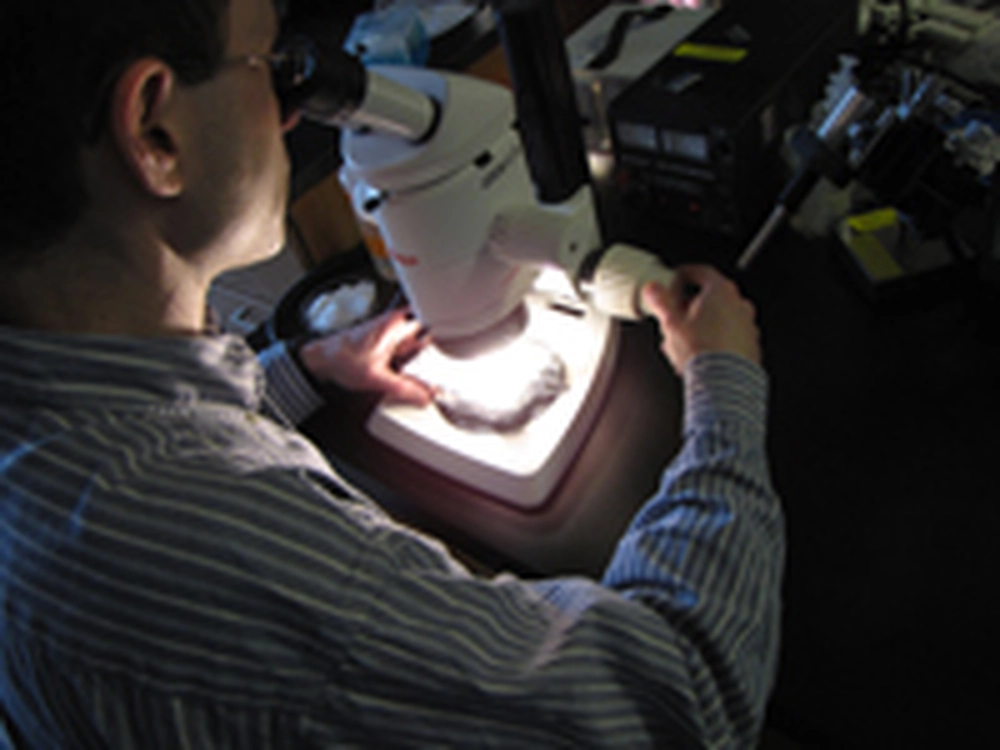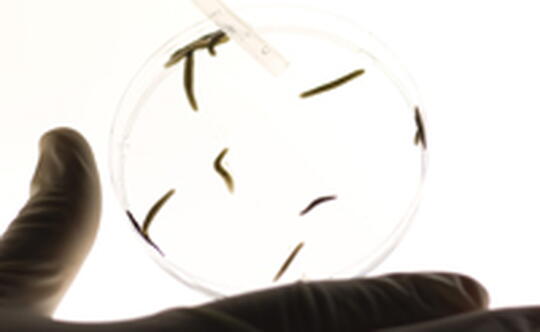
Newmark was one of 56 scientists chosen by the HHMI from among 1,071 applications for a five-year, renewable appointment as an HHMI investigator. The support for this latest cohort is $600 million over five years.
The HHMI, one of the nation’s largest philanthropies, has a total of 355 investigators, selected through rigorous national competitions. The investigators include 13 Nobel Prize winners and 124 members of the National Academy of Sciences.
Aside from generous research support, what makes the HHMI investigator appointment so vaunted is that it “funds the person, not the project.” According to the HHMI, the institution “values innovation and encourages its investigators to extend the boundaries of science. Investigators have the freedom to explore and, if necessary, to change direction in their research. Moreover, they have support to follow their ideas through to fruition — even if that process takes many years.”
“It’s an incredible gift,” says Newmark. “Being an HHMI investigator gives you the freedom to focus on your science and tackle high-risk projects that may be difficult to pursue in the current funding climate. HHMI provides resources that enable you to follow your nose.”
Newmark has, in fact, been following his nose ever since the mid-1990s, when he became intrigued by the planarian, a free-living flatworm with an astounding ability to regenerate. Since then, he has been instrumental in resurrecting the planarian as a model system. Planarians can regenerate an entire organism, including a new brain, from nearly any part of the body; a population of adult stem cells provides the source of cells for regeneration.
One intriguing aspect of planarian biology, from Newmark’s perspective, is the animal’s ability to regenerate germ cells, the precursors of egg and sperm cells, de novo from stem cells. Newmark finds germ cells fascinating because they are highly differentiated yet they maintain their totipotency—the ability to produce all the cells in an organism.
Being named an HHMI investigator is recognition that others have faith in his ideas.
The appointment is also gratifying to members of MCB, who demonstrated similar faith in 2001 by offering Newmark his first independent faculty position.
The vast majority of scientists devote their careers to making steady but incremental progress on previously established lines of research,” said CDB chair Andrew Belmont at the time of the announcement. “In contrast, a very select, very small group of scientists instead pioneer completely new approaches and methodologies, which then serve a much broader community. Dr. Newmark falls into the latter class of scientists, and it is tremendously satisfying to see the HHMI reward him for his vision, risk-taking, and hard work.”
Newmark is one of three HHMI investigators at the University of Illinois. In 2005, physics professor Taekjip Ha was named an HHMI investigator, and chemistry professor Wilfred van der Donk was appointed at the same time as Newmark.
“The Hughes funds have allowed my group to pursue several new experimental avenues and have permitted me to expand my research team. The number of excellent young scientists interested in planarians continues to grow and it is great to be able to bring some of them on board,” says Newmark.
Some of these new experimental approaches involve moving from microarray analysis to next generation sequencing technologies to characterize some cell types in the planarian. These experiments should help elucidate how stem cells choose different fates and progress along various differentiation pathways.
“These resources will help us improve our knowledge of the planarian genome, which will be of use to the whole community,” says Newmark. “We hope to have a much more complete picture of the cell types in which these genes are expressed on a different scale than we’ve been able to achieve thus far.”
The lab also just received a new confocal microscope that will dramatically improve their imaging capabilities. The new microscope will provide better resolution and reconstruction of tissues in the animal, and is able to separate more colors, so more markers to distinguish more different cell types and components of different organs can be used. Plans are also afoot to develop techniques for culturing planarian stem cells.
“I’ve been really itching to get started,” says Newmark. “Now that the culture room has been renovated, we can get to work.”
Without the Hughes appointment, Newmark would not be able to embark on these experiments.
“If you are in survival mode and just to try to get by, it’s unlikely that you’ll do new things until you can make sure the old things are okay,” says Newmark. The Hughes appointment “will enable us to branch out and to pursue questions at a different level than we have in the past.”
One of those big questions is, what are the signals or cues that tell a cell to become a germ cell? Ongoing molecular investigations in Newmark's lab hold the promise of defining the make-up of a germ cell, and whether the signaling that triggers germ cell development has been conserved across species.

Asking these kinds of compelling questions has driven Newmark for much of his career. And his colleagues have taken notice: the HHMI investigator position is just the latest of several honors he has received, including being one of five recipients nationwide of the 2003 Damon Runyon Scholar Award and the 2003 CAREER Award from NSF.
In 1988, after earning a bachelor’s degree in biology from Boston University, Newmark went to graduate school at the University of Colorado, Boulder. He worked with Drosophila in Robert Boswell’s lab to learn how organisms make germ cells and how determinants get localized in the embryo to tell cells how to differentiate.
Then, having read some papers on regeneration in planarians for a journal club, Newmark discovered a fascination with that topic.
“I thought they were the coolest animals I had seen,” says Newmark of planarians. “It’s one of these fantastic unanswered questions: how do organisms regenerate? Very few scientists were looking at that process with molecular techniques.”
Newmark was surprised to discover that no one in the U.S. was working with planarians to study regeneration at a molecular level; in fact very few people worldwide were studying regeneration in any system. So, to learn more about the biology of planarians, Newmark began his postdoctoral work in the laboratory of Jaume Baguña at the University of Barcelona. Not only did he learn planarian biology in Barcelona, but his daughter, Elena, was also born there.
After a chance meeting at a scientific conference in York, England, Newmark joined forces with Alejandro Sánchez Alvarado (now an HHMI investigator at the University of Utah), who was studying regeneration in amphibians at the Carnegie Institution of Washington’s Department of Embryology in Baltimore. Newmark worked with Sánchez Alvarado for about five years and together they were able to make some major breakthroughs that helped revitalize the study of planarians. For example, labs had been trying since the late 1960s to label planarian stem cells and no one had succeeded.
“I spent several years failing miserably (at that project), as had everybody who worked on planarians since the 1960s,” says Newmark. “Entire labs had shut down and switched to other organisms because they could not label the planarian stem cells.”
A scientist friend of Newmark’s suggested he just feed the planarians one such label, BrdU.
“That’s a great idea, why don’t I try it?” Newmark remembers thinking.
At this point in his life, Newmark’s second child, Carl, was very young and Newmark remembers being completely sleep deprived.
“It was probably one of the worst experiments I’ve ever done,” Newmark laughs. “I globbed the label with the liver paste planarians typically eat and just dropped it into the water. The water got all cloudy. It was a disaster, but the worms did eat it. I didn’t really know what concentration of label they ingested; the way I did it, who knows?”
Soon afterwards, Newmark fixed the six planarians for staining. Late one night he was ready to look at them under the microscope.
“The first one: nothing; the second one: nothing; third one: nothing; fourth one: nothing and I’m thinking, why do I keep doing this?” says Newmark. “Why do I keep wasting my time? Fifth one: nothing. But the sixth one was just beautiful. I called Alejandro at home and told him ‘you’re not going to believe it.’”
Newmark felt that same sense of stunned surprise the day last spring when he returned from a faculty meeting. There was a “very, very light Fed Ex envelope on the floor of my office. We get oligonucleotides sent to us via Fed Ex all the time and my first thought was, ‘why am I getting oligos in my office?’”
Then he saw the return address said Tom Cech, president of HHMI, and his very next thought was, “this is way too thin to be good news.
“So I opened it up and … I had to sit down for several minutes. Then I staggered out to the lab to have someone else read it to make sure it said what I thought it said,” he says, beaming.
Next Newmark called his wife, Sonia, who was in Boston visiting her family, and then took his lab out to dinner.
The next day, they were back at work.